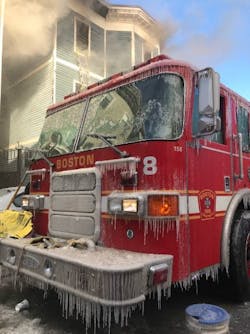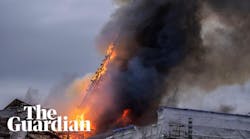This column is a component of VFIS' "Operation Safe Arrival" initiative, aimed at heightening safety awareness and reducing the frequency and severity of accidents involving emergency vehicles.
Winter is here and when the temperatures fall below the freezing mark, there are a number of special hazards that can present themselves to emergency service organizations. This article will focus on some of these hazards and prevention methods to insure safe operation of fire apparatus.
Take a moment to review the following topics. By acting on them, you can help insure the only thing that freezes this winter is your local ice skating pond and the only thing that falls is the temperature.
Tires
Tire condition is always important; but for winter operations it's critical. The two main areas of concern are proper inflation and tread depth. Over- and under-inflation can both cause problems with traction and steering control. Over-inflation can actually reduce the amount of surface area that comes in contact with the road. During long trips (and in warm weather) it can also contribute to blowouts due to overheating.
Under-inflation is a particular winter hazard. In the summer, tire pressure naturally expands several PSI due to heat buildup from contact with road surfaces than can exceed 125 degrees F. However, with colder ambient temperatures in the winter, this natural expansion will not take place leaving the tire under-inflated. This can cause over-flexing of the sidewalls, which can lead to blowouts through physical contact with the road surface. Under-inflation may also make it difficult to install snow chains because of the improper configuration of the tire.
Another critical area of tire condition is tread depth. Inadequate tread depth may greatly reduce moisture displacement and cause insufficient traction on snow or slush covered roadways. Obviously, loss of traction will affect speed and directional control, as well as braking efficiency.
Air Brakes
Air brake systems on apparatus need special attention during cold weather operation. Compressed air usually has some water in it. This moisture, which is produced in the compression process, is bad for the air brake system. In cold weather, it can freeze and cause brake failure.
You should routinely drain the water, which tends to collect at the bottom of the air tank, completely to prevent ice from forming in the brake lines. Each air tank is equipped with a drain valve located on the bottom of the tank. There are two general types of systems: manual and automatic. The manual systems can be maintained by simply opening the quarter-turn valve on the bottom of the air tank and draining the moisture.
Some brake systems are equipped with automatic drain systems; however they may also be equipped for manual draining. Automatic systems may be available with electric heating devices. These help prevent freeze-up of the automatic drain in cold weather, but even when so quipped, they should be tested and maintained to insure proper operation.
Snow Chains
If we have to explain to you what snow chains are, then there is a real good chance you are not going to need them. However, if you know what they are, and your organization owns a set (or two or six), then there are a few things you need to take care of before you have to use them.
First, visually examine the chains' cross links and replace any that are worn or damaged. Also look for any attachment hooks ("S" hooks) that are spread and re-secure them. Before the threat of snow is present, place the chains on the apparatus to test the fit. Tire wear since the last fitting may cause the chains to be too loose. Tire replacement may make them too tight. Adjust the chains for the proper fit and mark them for proper wheel placement for when they are needed (i.e. "Engine 1, right rear"). As previously mentioned, make certain that the tires are properly inflated to insure safe operation and proper fit of the snow chains. Pre-fitting the chains will also provide you with an opportunity to train personnel on the safe and proper methods of installation.
If the apparatus has been equipped with automatic chains, refer to the manufacturer's recommendations for maintenance and inspection. Make any necessary adjustments or repairs, and check for proper operation.
Wiper Blades And Washer Fluid
In terms of windshield wiper requirements, there is a huge difference between moving rain water during a spring shower and removing slush and road spray from a salt covered highway. Inspect the wiper blades to insure that they are in good condition and make full contact with the windshield. If there is any indication of inadequacy, the blades should be replaced. In selecting a replacement blade, give consideration to the typical winter conditions in your area. If you operate in areas with routinely severe winter conditions, there are some wiper blade manufacturers that make a winter blade assembly that have a protective cover over the blade arm to prevent ice build-up. There are also blades with multiple edges that may provide additional scraping power. Select a blade that matches your apparatus requirements and the needs required by your weather environment.
You should also routinely check the windshield washer reservoir to make certain that it is full and contains washer anti-freeze to prevent icing and aid in clearing the glass. When adding windshield washer anti-freeze, always pump some of the new anti-freeze through the system to displace any water or weak antifreeze in the pump, tubing or nozzles.
Pumps
To prevent water from freezing in fire pumps, there are a number of steps that can be taken. The first is to simply insure that the heating system in the building where the apparatus is housed is working properly. This is particularly important in regions of the country that normally don't experience below-freezing temperatures. A heating system that isn't regularly used or maintained can fail during a period of unusually cold temperatures.
Unless it is extremely cold, pumps rarely freeze up during response. However when the apparatus is stopped outside, freezing can occur rather quickly. One good method of protection is to simply circulate water between the pump and tank while the apparatus is parked or not actively pumping water.
If it is extremely cold and/or the station housing the vehicle can't be adequately heated, draining the pump and leaving the drain valve open while in the station will prevent damage to the pump. However, if this method is used, pump operators need to be aware of this so they will not experience any delay in priming the pump if it is needed for fire suppression. These draining procedures may be followed to protect intake and discharge piping as well.
Leaks
Even the best fire apparatus leaks water occasionally. Loose packing, a drain valve that won't seat properly, a worn tank valve -- all will permit leakage. Most of the time this isn't a major problem -- that is, until the temperature drops below freezing. Then even minimal drip rates can lead to significant mishaps. That gallon of water that dripped onto the roadway while you were investigating a false alarm could freeze and just be slippery enough to cause an unsuspecting motorist to lose control and crash. Or, it could cause a pedestrian or cyclist to slip and fall. As the leaks get larger, so does the potential for injury or damage. Routinely look for leaks and have them promptly repaired.
Slip Prevention
To help prevent slips and falls around apparatus at operations during freezing temperatures, a mixture of dry sand and either rock salt or calcium chloride should be carried on apparatus or readily available on service vehicles. This may also be used to eliminate slippery road conditions after you mop up, to prevent a traffic hazard due to water leakage on the cartway, or to protect pedestrians from slipping and falling on sidewalks.
Firefighting operations during the winter months offer some significant challenges. A little forethought and preventive planning can help reduce or eliminate some of these challenges. A quick review of these key points can prevent your organization from being placed in a hazardous situation as well as avert conditions that could damage your apparatus or cause injury to your personnel and the public at large.






